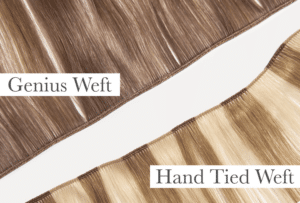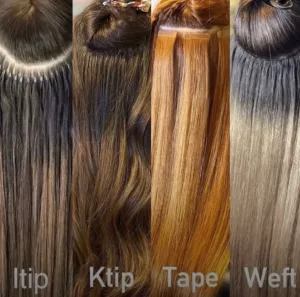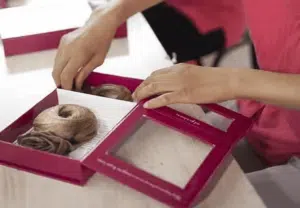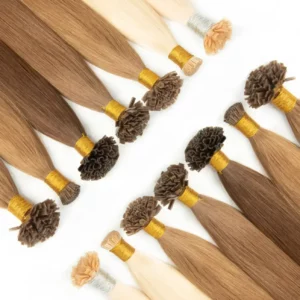Ever had a client nervously ask, “can you see tape in extensions?” I’ve been there—clients are always anxious about visibility. Relax, because I’ll break down exactly how visible tape-ins really are and how you can ensure they’re undetectable.
When properly applied, tape-in extensions are virtually invisible. Strategic placement, matching hair color, and careful blending ensure extensions remain discreet, even when the hair is up.
Stick around—I’ll teach you exactly how to hide tape-ins perfectly, every single time.
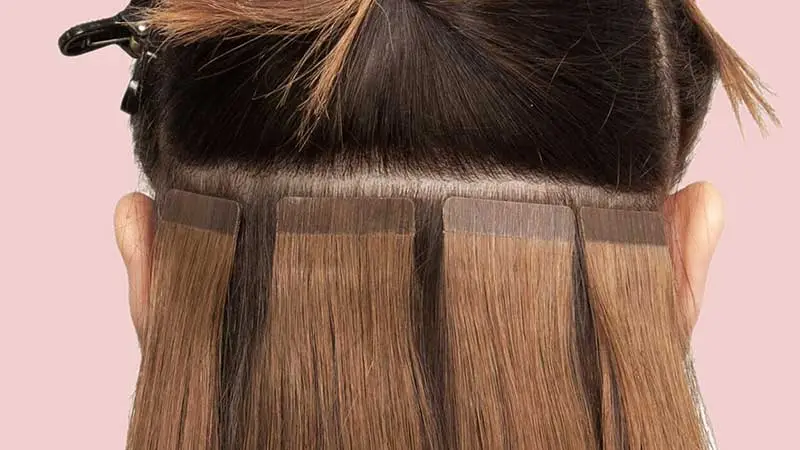
Can You Actually See Tape In Extensions?
If you’re wondering, “Are tape in extensions easy to see?”—the straightforward answer is: not if they’re done correctly. Poorly installed or incorrectly color-matched tape-ins can definitely stand out, but when professionally applied, they’re nearly impossible to detect.
The key is all about proper installation and knowing how to blend them seamlessly.
How to Ensure Tape-In Extensions Aren’t Visible
Match Hair Colors Accurately
The biggest giveaway with tape-ins is mismatched color. Always use extensions that perfectly match your client’s hair color—or blend multiple shades—to keep them invisible. Remember, subtle tonal variations often produce the most natural results.
Correct Placement Is Critical
Placement matters—a lot. Avoid installing extensions too close to hairlines, parts, or areas prone to exposure. Positioning them beneath a thin layer of natural hair keeps them hidden, even during movement.
Thin Sections are Key
Using thin, carefully measured sections of natural hair to sandwich between tapes ensures they’re virtually undetectable. Thinner sections also create less tension and enhance comfort.

Can You See Tape-Ins When Hair is Up?
When clients ask, “can you see tape-ins when your hair is up?”—the answer should always be “no,” as long as you’re careful. Here’s exactly how to guarantee discretion:
Strategic Placement
Position extensions slightly away from the hairline and avoid areas around natural partings. A slight offset from hairlines ensures coverage when hair is pulled back.
How Many Extensions You Use Matters
For hairstyles frequently worn up, fewer extensions at the perimeter and hairline keep bonds hidden effortlessly. Focus on density in the crown area for fuller volume without visibility.
Styling for Updos
Teach your clients how to loosely gather or braid their hair to conceal tapes fully. Soft, relaxed hairstyles make it easier to hide tape-in bonds.

FAQ
1.Can you see tape-ins through fine hair?
Not if they’re installed carefully. Use smaller, thinner extensions, and ensure the tapes are placed strategically beneath denser sections of hair.
2.How long do tape-in extensions stay invisible?
Typically, tape-ins stay discreet for 6-8 weeks. Afterward, natural hair growth can make tapes more noticeable, requiring professional adjustments.
3.Can you reuse tape-in extensions and keep them invisible?
Yes, high-quality extensions can be reused multiple times. Just make sure the adhesive is thoroughly cleaned and replaced regularly for best results.
4.What’s the best way to care for tape-ins to keep them hidden?
Regular brushing, gentle shampooing, and careful styling keep extensions looking natural. Encourage clients to avoid tight ponytails or buns that strain the tape areas.
5.Can you feel tape-in extensions?
Properly applied tape-ins feel comfortable and lightweight. If a client feels discomfort, it usually indicates improper placement or too much tension.
6.Are tape-in extensions visible in thin hair?
With careful placement and thin sections, tape-ins blend seamlessly even in thin hair, making them virtually invisible.
7.Tape-in extensions before and after thin hair—how noticeable is the change?
Tape-ins can dramatically enhance thin hair, adding volume without being visibly noticeable if correctly matched and placed.
8.How to hide tape-in extensions when putting hair up?
Strategically place extensions away from the hairline, use thinner sections, and style hair loosely or softly braided to completely conceal tape-ins.
9.Are tape-in extensions noticeable when hair gets wet?
If applied correctly, tape-ins should remain discreet even when wet. Encourage gentle handling and drying techniques to maintain invisibility.
10.Can you see tape-in extensions if the wind blows?
If properly secured and well-placed, wind shouldn’t expose tape-ins. Using fine, thin sections helps keep extensions concealed under natural hair.
11.Can tape-ins cause visible hair damage?
Properly applied tape-ins do not cause visible damage. Incorrect removal or poor maintenance can lead to damage, making visibility issues more likely.
12.Are tape-ins noticeable when wet?
Typically, no. Properly installed and well-blended extensions remain discreet even when wet, though correct styling afterward is important.
13.How frequently should tape-ins be adjusted to remain invisible?
Ideally, every 6-8 weeks to keep the extensions discreet and secure.
14.Can you feel tape-in extensions once they’re in?
Initially, clients might feel slight pressure, but after a few days, properly applied extensions become virtually unnoticeable.
Conclusion
Tape-in extensions, when applied professionally and maintained properly, are one of the most discreet and effective extension methods available. Mastering techniques like precise placement, color-matching, and proper care can ensure they remain invisible and comfortable for your clients. For consistently undetectable tape-ins, always opt for high-quality extensions like those from Hibiscus Hair.

